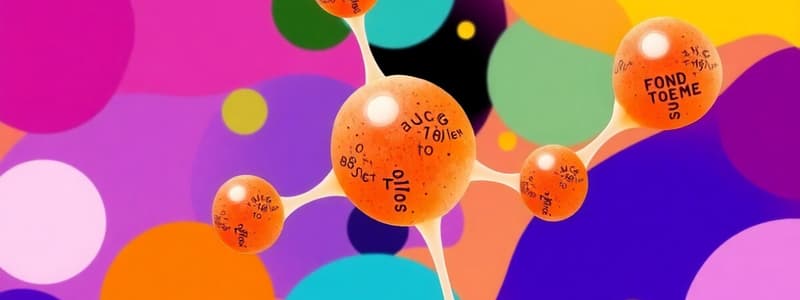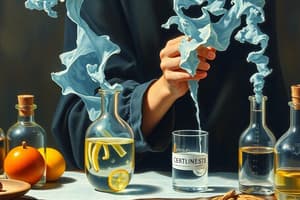Podcast
Questions and Answers
What are the primary elements that constitute carbohydrates?
What are the primary elements that constitute carbohydrates?
Carbon, Hydrogen, and Oxygen.
Briefly describe the role of proteins in living organisms.
Briefly describe the role of proteins in living organisms.
Proteins are required for the synthesis of new protoplasm for growth and repair of worn-out cells.
What color change indicates a positive result in a starch test using iodine in potassium iodide solution?
What color change indicates a positive result in a starch test using iodine in potassium iodide solution?
The mixture turns from yellowish-orange to blue-black.
Name two examples of large molecules that are synthesized from glucose.
Name two examples of large molecules that are synthesized from glucose.
Describe the relationship between DNA, genes, and chromosomes.
Describe the relationship between DNA, genes, and chromosomes.
List the three components of a nucleotide.
List the three components of a nucleotide.
In DNA, which base pairs with Guanine (G)? Which base pairs with Adenine (A)?
In DNA, which base pairs with Guanine (G)? Which base pairs with Adenine (A)?
Name the enzyme that unwinds the double helix during DNA replication.
Name the enzyme that unwinds the double helix during DNA replication.
What is the role of DNA ligase in DNA replication?
What is the role of DNA ligase in DNA replication?
Briefly explain the principle behind how gel electrophoresis separates DNA fragments.
Briefly explain the principle behind how gel electrophoresis separates DNA fragments.
What role does mitosis have in living organisms?
What role does mitosis have in living organisms?
Explain how the nuclear division and cytokinesis are different.
Explain how the nuclear division and cytokinesis are different.
Give one example of a causative factor for cancerous growth.
Give one example of a causative factor for cancerous growth.
Describe one way non-ionizing radiation can cause damage to living organisms.
Describe one way non-ionizing radiation can cause damage to living organisms.
Briefly describe the process of angiogenesis in cancer development.
Briefly describe the process of angiogenesis in cancer development.
Explain the difference between a haploid and diploid cell.
Explain the difference between a haploid and diploid cell.
What is meant by a homologous pair of chromosomes?
What is meant by a homologous pair of chromosomes?
What type of cell division gives rise to genetically dissimilar cells in which the chromosome number is halved?
What type of cell division gives rise to genetically dissimilar cells in which the chromosome number is halved?
What type of cell is created by meiosis?
What type of cell is created by meiosis?
How does crossing over contribute to genetic variation during meiosis?
How does crossing over contribute to genetic variation during meiosis?
Flashcards
Elements in Carbohydrates
Elements in Carbohydrates
Carbon, Hydrogen, and Oxygen
Elements in Fats
Elements in Fats
Carbon, Hydrogen, and Oxygen
Elements in Proteins
Elements in Proteins
Carbon, Hydrogen, Oxygen, Nitrogen, and sometimes Sulfur
Role of Carbohydrates
Role of Carbohydrates
Signup and view all the flashcards
Role of Fats
Role of Fats
Signup and view all the flashcards
Role of Proteins
Role of Proteins
Signup and view all the flashcards
DNA, Genes, & Chromosomes
DNA, Genes, & Chromosomes
Signup and view all the flashcards
What is DNA?
What is DNA?
Signup and view all the flashcards
Phosphodiester Bond
Phosphodiester Bond
Signup and view all the flashcards
Complementary Base Pairing
Complementary Base Pairing
Signup and view all the flashcards
Semi-Conservative Replication
Semi-Conservative Replication
Signup and view all the flashcards
Helicase Function
Helicase Function
Signup and view all the flashcards
Primase Function
Primase Function
Signup and view all the flashcards
DNA Polymerase III
DNA Polymerase III
Signup and view all the flashcards
DNA Polymerase I
DNA Polymerase I
Signup and view all the flashcards
DNA Ligase Function
DNA Ligase Function
Signup and view all the flashcards
Gel Electrophoresis
Gel Electrophoresis
Signup and view all the flashcards
Mitosis
Mitosis
Signup and view all the flashcards
Nuclear Division vs. Cytokinesis
Nuclear Division vs. Cytokinesis
Signup and view all the flashcards
Carcinogens
Carcinogens
Signup and view all the flashcards
Study Notes
-
Chemical elements in carbohydrates are carbon, hydrogen, and oxygen.
-
Fats consist of carbon, hydrogen, and oxygen.
-
Proteins contain carbon, hydrogen, oxygen, nitrogen, and sometimes sulfur.
-
Proteins have primary, secondary, tertiary, and quaternary structures.
-
Carbohydrates provide an immediate source of energy.
-
Fats insulate against heat loss and provide long-term energy storage.
-
Proteins synthesize new protoplasm for growth and repair.
Tests
-
Starch test: iodine in potassium iodide solution turns blue-black if positive.
-
Negative starch test: The mixture remains yellowish-orange.
-
Reducing sugars test: Benedict's solution turns brick red (large amount), orange (moderate), yellow (low), or green (trace) if positive.
-
Negative reducing sugars test: The mixture remains blue.
-
Protein test: Biuret solution turns violet/lilac if positive.
-
Negative protein test: The mixture remains blue.
-
Fats test: Ethanol creates a white emulsion when water is added if positive.
-
Negative fats test: The mixture remains clear when water is added.
-
Large molecules like cellulose, glycogen, and starch are synthesized from glucose.
-
Polypeptides and proteins are synthesized from amino acids.
-
Lipids are synthesized from glycerol and fatty acids.
DNA Structure and Function
- Genes are segments of DNA, and chromosomes are long DNA strands containing many genes.
- DNA is a double helix of two nucleotide strands, each nucleotide contains a sugar, a phosphate group, and a base (A, G, C, or T).
- Condensation reactions join nucleotides, forming di- and polynucleotides, linked by phosphodiester bonds.
- Complementary base pairing: guanine to cytosine, and adenine to thymine.
Semi-Conservative DNA Replication
- Begins at the origin of replication.
- Helicase unwinds the helix by breaking hydrogen bonds between base pairs of parental strands.
- Each parental strand serves as a template for a new DNA strand.
- Primase synthesizes an RNA primer, providing free 3' OH ends for DNA polymerase III.
- DNA polymerase III elongates the new strand in the 5' to 3' direction, forming phosphodiester bonds.
- Deoxyribonucleotides are incorporated by base pairing: adenine to thymine, guanine to cytosine.
- The leading strand synthesizes continuously, while the lagging strand forms Okazaki fragments discontinuously.
- DNA polymerase I replaces RNA primers with deoxyribonucleotides.
- DNA ligase seals gaps in Okazaki fragments by forming phosphodiester bonds.
Gel Electrophoresis
- DNA's negative charge causes it to migrate toward the anode under electric current within an agarose gel.
- The agarose gel acts as a molecular sieve separating DNA by size.
- Larger DNA fragments migrate slower and travel a shorter distance while smaller fragments travel further.
- Loading dye marks DNA migration in the gel.
- One dye runs faster than most fragments.
- Another dye migrates with very large fragments.
- DNA sample migrates in between the dyes.
- Glycerol makes DNA samples denser than the running buffer, causing them to sink into the well.
- Dye stains the agarose gel and nucleic acid dyes bind to DNA to visualize DNA under UV or blue light
Cell Cycle, Mitosis & Meiosis
-
Mitosis is asexual reproduction that produces genetically identical cells and maintains chromosome number.
-
Mitosis is important for growth, repair, and asexual reproduction.
-
Mitosis & Meiosis II are very similar
-
Nuclear division divides the nucleus, cytokinesis divides the cytoplasm during the last stage of cell division.
-
Cancer development involves accumulated mutations, angiogenesis, and metastasis.
-
Mutation accumulation results in uncontrolled cell division and tumor formation.
-
Angiogenesis is when malignant tumors promote new blood vessel growth for oxygen and nutrients.
-
Metastasis: tumors spread and establish in other body locations.
-
Haploid cells have one set of chromosomes.
-
Diploid cells have two sets of chromosomes, one from each parent.
-
Reduction division process (meiosis) halves chromosome number for correct chromosome number after egg and sperm fusion.
-
Homologous chromosomes: matching pairs with same genes/alleles.
-
One member of the pair from each parent.
-
They share the same size, shape and sequence of genes.
-
Meiosis yields genetically dissimilar cells with halved chromosome number by separating homologous chromosomes.
-
Meiosis is used in gamete formation.
-
Meiosis and fertilization can lead to genetic variation.
-
Independent assortment: chromosome pairs line up randomly during meiosis I.
-
Which chromosome of a given pair goes to which pole is independent of the behavior of the chromosomes in other pairs
-
Crossing over of segments results in new allele combinations on chromosomes in the haploid cells so produces almost unimaginable variation.
-
Both generate high degree of variation
-
Random fusion of male and female gametes in sexual reproduction.
Studying That Suits You
Use AI to generate personalized quizzes and flashcards to suit your learning preferences.




